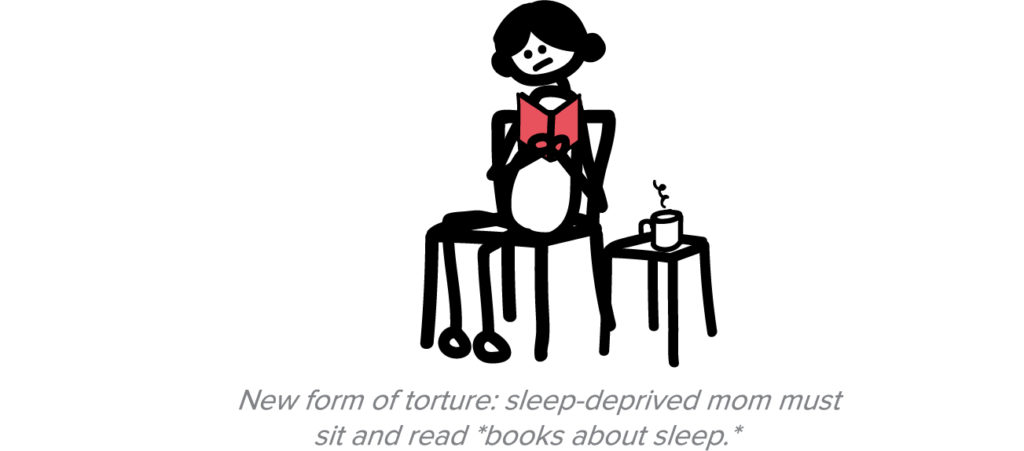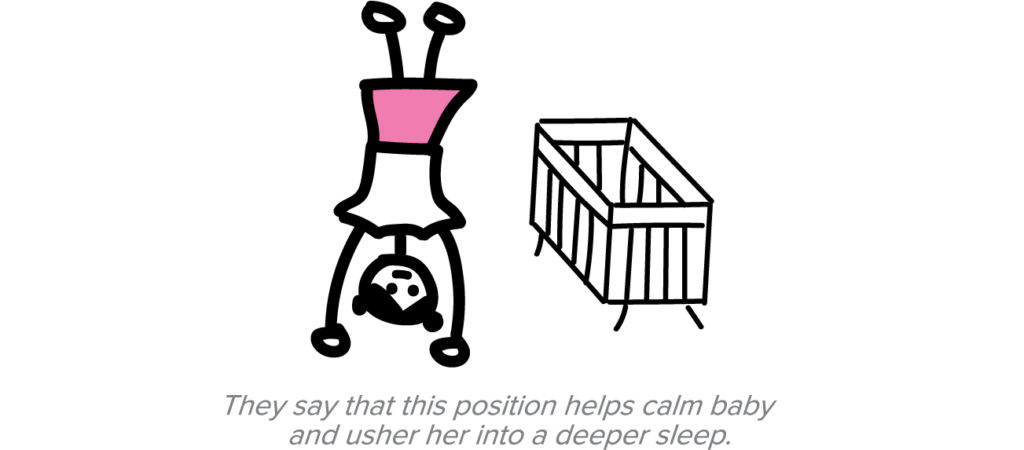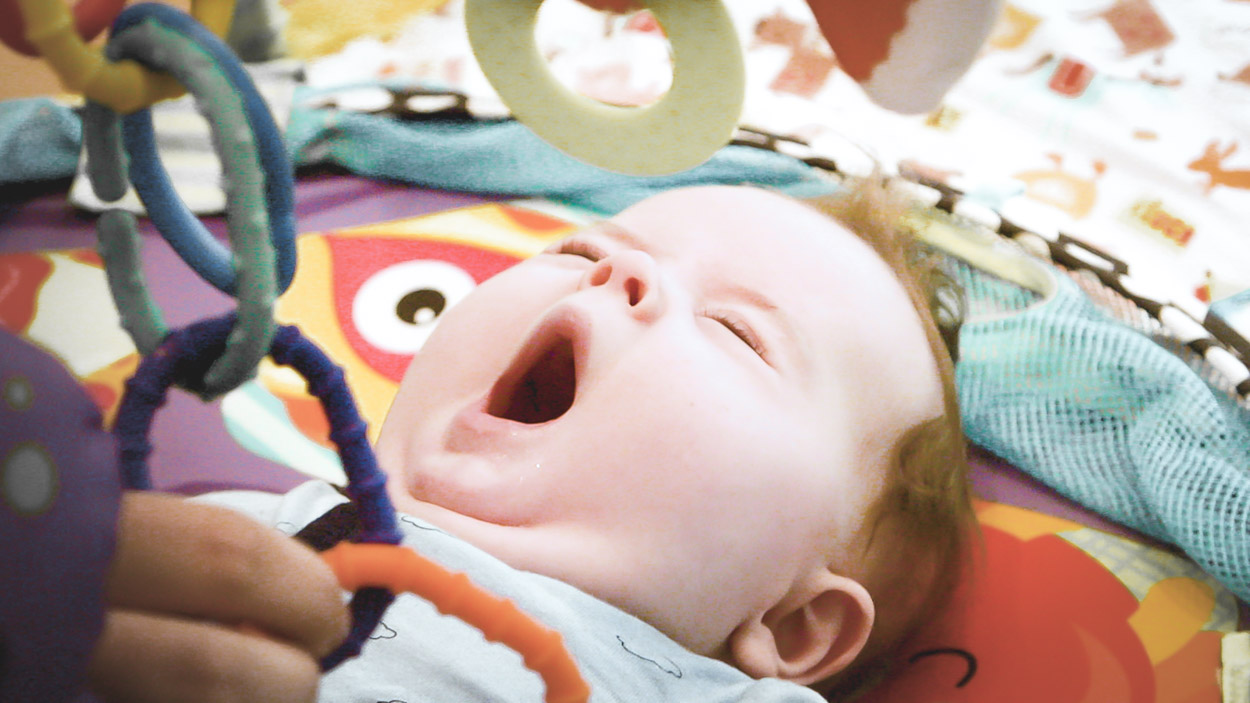

As anyone who is or ever has been pregnant knows, one of the most annoying things that occurs throughout the nine months is friends and strangers alike chuckling knowingly and saying “Sleep while you can!”
(I say “one of” because the actual most annoying thing in my pregnancy was my husband responding to wishes of congratulations with “We’ll see! Who’s to say it’s mine?!”)
There’s no way to overstate the importance of the topic of sleep to any new mother. It’s Everything. Times infinity. So much so that you might find yourself calling your insane cousin to ask if she can repeat every word of what seemed like self-important rambling when she cornered you at your baby shower to proselytize about her “miracle” sleep-sack. And though the concept of a “bedtime routine” once seemed too obvious to even think about, you suddenly find yourself on Amazon at 2:42am ordering the book that the grocery store cashier told you her daughter swore by.
I also know how hard it is for new moms to stay awake long enough to read more than a page of any book — let alone a book about sleep. So, as a public service, I hereby present a roundup of some of today’s go-to Sleep Bibles, in order from hard-core to gentle. I have real-life friends who swear by each of these, and all are a) alive, b) sane and c) mothers of children who sleep through the night.
Sleep training, defined
Sleep-training is the art of teaching your babies to sleep when they wouldn’t otherwise.
This almost always involves some amount of crying (baby’s, sometimes yours, too), as you teach your baby to get into a routine that works for you both. Think of the various methods as falling along a spectrum according to how much crying you can tolerate (and at what age). Another way to look at it is that you have to decide whose needs and/or preferences reign supreme: yours or the baby’s. The “middle ground” sleep approaches with more flexibility may seem like an obvious best bet, but they can take longer to implement, so it can be hard for exhausted parents to stick with the process.
There truly is no best method for sleep training — what works for one family won’t necessarily work for another — and some families decide not to do it at all. But the good news is that pretty much any sleep method will work if you stick with it; babies, like all humans, are pattern-seekers, and, as with so much else in life, consistency is key.

1) The New Contented Little Baby Book: The Secret to Calm and Confident Parenting by Gina Ford
This is some of the most rigorous and prescriptive advice on the market, and Ford has rabid devotees whose newborns (!) sleep through the night. She sets a firm sleep routine for babies as young as one week old — which is pretty radical — and is a proponent of strict feeding and nap schedules even for newborns. Though her critics consider her methods Draconian, she backs them up with a great deal of research.
Pros: This book is detailed and clear and therefore great for moms looking for concrete instructions and someone to please just TELL THEM WHAT TO DO FOR THE LOVE OF GOD. The success stories boast babies sleeping 12 hours straight by a month or two – much younger than other methods.
Cons: Ford can seem harsh, especially to those who aren’t comfortable with letting a newborn scream for long periods of time alone in a bassinet or crib. It’s not only strict but rigid, and it takes a backbone of steel to adhere closely to its instructions. Some feel it discourages cuddling, as Ford permits it only in moderation – i.e. when the schedule allows for it.
2) On Becoming Baby Wise: Giving Your Infant the Gift of Nighttime Sleep by Robert Bucknam M.D. and Gary Ezzo, M.A.
Their method is based on the principle that stretching feedings farther apart will lead to longer stretches of sleep. It advocates a “parent-directed feeding” method (instead of “on-demand”), which calls for feeding on a schedule based on baby’s age beginning almost from birth.
Pros: The predictability of this routine (which involves an “eat-play-sleep” cycle) is appealing to many parents. It not only provides a much-needed daily structure to the chaotic early weeks and months, but can be effective at getting babies both on a feeding and sleeping schedule.
Cons: This approach has been criticized for stretching feedings too far apart for babies at too early an age — and many disagree with imposing a schedule on such young babies.
3) Healthy Sleep Habits, Healthy Child by Marc Weissbluth M.D.
One of the most beloved sleep-training bibles, this book advocates being attuned to your baby’s needs and putting him or her down for the night at the earliest signs of sleepiness. Weissbluth’s mantra: Perfect timing produces no crying. Though he addresses the sleep needs of babies from the earliest weeks, the official training approach is meant to begin at four months.
Pros: This book contains a great deal of research about the biological sleep needs of babies up through toddlerhood, which helps parents feel that they’re making decisions that are appropriate for their child’s specific developmental phase. And four months is right about when most parents are ready to cry uncle on the sleep front, so many view this book as a true godsend.
Cons: Weissbluth’s method doesn’t allow for periodic check-ins if baby cries at bedtime, which is not workable for many parents who don’t like the idea of not being able to soothe a crying infant. And the “perfect timing” theory means that, in practice, a baby’s bedtime is often around 6pm, which is not workable for many families (especially those with older children).

4) The Sleepeasy Solution by Jennifer Waldburger and Jill Spivack
This book advocates a gradual cry-it-out approach and is more flexible than Weissbluth’s, providing for regular reassurance check-ins. Often described as the “LA Sleep Gurus,” Waldburger and Spivack are mindful that families have a wide range of sleep values and that there is no one-size-fits-all approach.
Pros: The authors explicitly contemplate and allow for modifications to their advice, making it gentler set of guidelines. It’s easy to follow, offering sample schedules, step-by-step instructions for a range of sleep-related issues, and night-weaning guidelines.
Cons: There’s little in the way of troubleshooting in the event the book’s suggestions don’t seem to be working.
5) The Sleep Lady’s Good Night Sleep Tight by Kim West
This book offers an alternative approach to letting baby cry and instead relies on the “shuffle” method, which involves putting baby down awake and comforting him or her while staying near the crib. Every few nights, the parent steps further away, soothing baby from increasing distances.
Pros: Offers some middle ground for parents who want to avoid baby crying but aren’t quite Attachment Parenting devotees — and thus want their babies on a schedule that works for them. It is flexible and, many feel, comfortingly humane for both the baby and parents.
Cons: West’s advice often comes across as half-hearted, given how frequently it is couched with exceptions. Further, it is a fairly high-maintenance approach in that it’s both gradual and time-consuming, so parents may find it hard to sustain. Also, this method is designed for babies six months or older, which is way too long to wait for many exhausted parents.
6) The No-Cry Sleep Solution by Elizabeth Pantley
Pantley’s approach does not involve any unattended crying. Instead, parents are to soothe their babies as necessary even as they employ her gentle training methods. Although Pantley acknowledges that other methods work more quickly than her “no-cry” approach, she believes hers is more effective in the long run given that it is based on a baby’s natural rhythms and individual sleep patterns.
Pros: No crying! For Attachment Parenting devotees, this makes Pantley’s the only palatable book on this list. She offers suggestions for how to break the feeding-sleep association and thus help babies sleep for longer stretches at night.
Cons: The whole point of “sleep training” is that it teaches a baby to sleep before he or she may end up doing so on his or her own – which often isn’t until close to a year old. This book is attuned purely to the baby’s preferred schedule, not the parent’s, which for some makes it a waste of money.







